Dr. SATISH BHAT
Plastic, Cosmetic and
Reconstructive Surgeon

+91 94488 69425

Dr. SATISH BHAT
Plastic, Cosmetic and
Reconstructive Surgeon

+91 94488 69425

Dr. SATISH BHAT
Plastic, Cosmetic and
Reconstructive Surgeon

+91 94488 69425

Dr. SATISH BHAT
Plastic, Cosmetic and
Reconstructive Surgeon

+91 94488 69425

What is a scar?
A scar is the result of injury to body tissue/skin, formed during the natural process of healing - during recovery from the injury. The scar may be following an accident, old infection, previous surgery or even a birthmark.
Thus scar formation is an essential function of the human body.
The amount/quantity and appearance/quality of the scar depend on the nature of scar production by the individual person, and the particular area on the body that has the scar.it also depends on the severity of the initial damage. All these ultimately decide whether the final scar is acceptable/good OR disfiguring/unpleasant.
Are some scars more likely to give trouble than others?
The most troublesome scars, also difficult to treat, are the ones caused by a major burn injury - where injury has been deep. If the patient survives the initial episode, with surgery or skin grafting at times, the remaining scars are a permanent reminder of the frightening experience.
Sometimes, even minor wounds in a given person with poor scar quality, at unfavourable locations - such as the central chest, upper arm (shoulder area) or the ear (pinna) - are very notorious to produce unfavourable scars
What are the problems that a scar can cause?
Due to appearance - usually by superficial scars
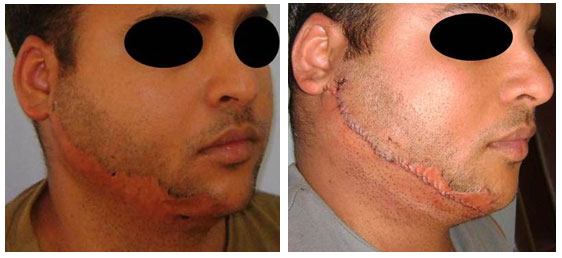
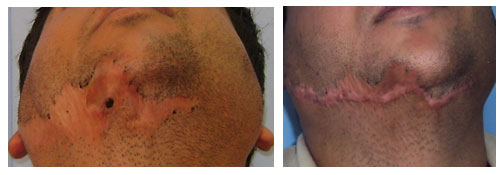
The central dark hole in the scar is depressed, with a tuft of hair and causing problems of hygiene and infection. This was corrected by excising that particular area of the scar. The patient was happy with the correction achieved and did not want any further treatment.
Due to other problems - usually by deformity or disability - seen with deeper scars
What are the unpleasant effects of a scar?
Visible external scars can cause the person to become self-coucious, this can lead to loss of self-esteem and self-confidence.
The loss of smartness may lead to a loss of opportunities in today's fast paced life with high expectation. Since there is a natural humal tendency to associate with someone who is smart or beautiful, presence of scars may lead to loss of progress in work place or even in personal life like marriage.
Correcting/improving the scar can restore the self-confidence, relieve the peer pressure, and give the person an opportunity to excel in life to the maximum potential.
What is meant by scar correction surgery?
This is a surgical procedure to improve an existing scar - to improve it's appearance or correct the deformity/disability that it may be causing.
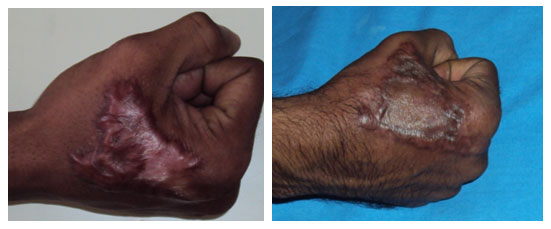
The above scar between the thumb and index finger was thickened, white in colour and embarrassing to the person. Surgical removal and cover with skin graft may not look perfect (esp. with some edges thickened), but it has solved his embarrassing problem
Can a scar be improved by means other than surgery?
Yes, it can - but there are limitations, to the alternative means to improved scars and even to surgical scar correction. Alternative means to correct scars will usually work only for thin/superficial scars. These include procedures such as Dermabrasion, Chemical peel or laser ablation. However, none of these will work for a thick/deep scar.
Another line of therapy includes use of steroid drugs, pressure therapy, gel sheets or even radiation to the scar - these measures usually used along with surgery, rarely by themselves also.
The best outcome is achieved by using a combination of all of these, in consultation with a Plastic Surgeon who has experience in each of these to give the patient the best result.
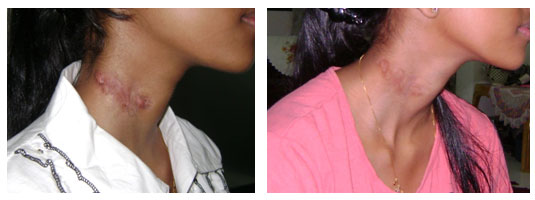
Above picture shows example of scar improved without surgery, with supportive steroid injection therapy
Can a scar improve by itself, without treatment?
Though every scar is expected to improve with time, some will not. What is more important is that which scars can misbehave is a matter that no surgeon can predict with assurance. Caucasian/White skin is considered to give the best result with any scar. Typical 'Indian skin' has a fair chance of giving problems, even among the 'fairer' lot.
When is the right time to correct/improve a scar?
The best time is the first instance when a scar is expected - ex- after injury. This involves simple measures that do not involve surgery, to get the best results. If there is a delay in using these simple measures, reversing an unpleasant scar that has already formed is more difficult.
There are ways to minimize chances of an unfavourable scar following a surgical procedure, even while the initial wound is being created and stitched up, but that is something done by a Plastic Surgeon. Other surgeons will take basic precautions by themselves, and take help of a Plastic Surgeon only if there is a genuine obvious concern, either before or after the surgery at any stage.
Hence, prevention is better that cure, as with everywhere else in life.
Who can undergo a scar correction procedure?
Any adult can take a decision to get a scar improved, in consultation with a surgeon. In case of someone less than 18 yrs, the decision is simple when there is a disability or obvious deformity. In case of subtle/minor disfigurements, the decision may have to be taken to avoid the secondary unpleasant effects (as mentioned above) and ensure peace of mind.
How much time is needed to improve the scar after surgery?
If surgery is done to improve the scar, the initial benefit will be immediate and obvious - however, the real challenge to the plastic surgeon is to ensure that with further progress in the healing, wound healing proceeds favourably to give a final scar that is also better than the previous one. Usually, if things stay favourable even 3 months after surgery, chances of subsequent problems are unlikely.
Is there any additional treatment needed after scar correction surgery?
As mentioned above, few of the non-surgical treatments options for a scar, work best in coordination with surgical correction - this includes local steroid injections, pressure garments and gel sheet application OR even strong measures like Radiation later on.
The below pictures show the benefit of supportive therapy after initial successful surgery, same person as in the pictures in the 1st case example above.
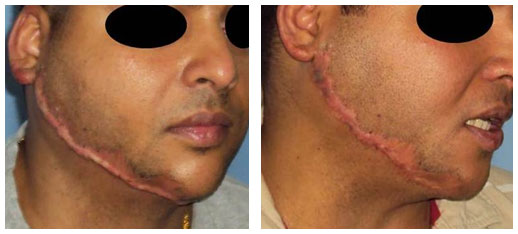
The initial picture here shows hypertrophy changes few days after surgery. With supportive therapy, the loss of initial benefit following surgery has been reversed.
Is the existing treatment available for scars always successful?
No, very often this is not enough. This is usually seen when the person originally has an unfavourable wound healing property - seen commonly in brown skin of Indian people. People with even darker skin - Negro race - have the highest risk, while 'white' skin seen in Caucasians have the least risk. This is the focus of medical research regarding wound healing at present.
In fact, the fear of scar problems can be a deterrent to certain types of skin reconstructive surgery procedures. One such procedure in brown skin - Keystone flaps - has been the focus of research by Dr. Satish Bhat, for which he has received the National award by his Plastic Surgery association at the 46th Annual meeting at Lucknow on November 6th, 2012.
Scars after burn injuries, whether or not treated by initial surgery, also tend to give very unfavourable scars.
SEARCH

LINEA Cosmetic Clinic, 1st Floor,
PARIN ARCADE, Collector’s Gate,
opp VAS Bakery, BALMATTA,
Mangalore – 575001, KARNATAKA, India
Ph: (91) 0824 2980 222
Mon to Sat, 11AM to 2PM & 5 – 7:30PM
FOLLOW US